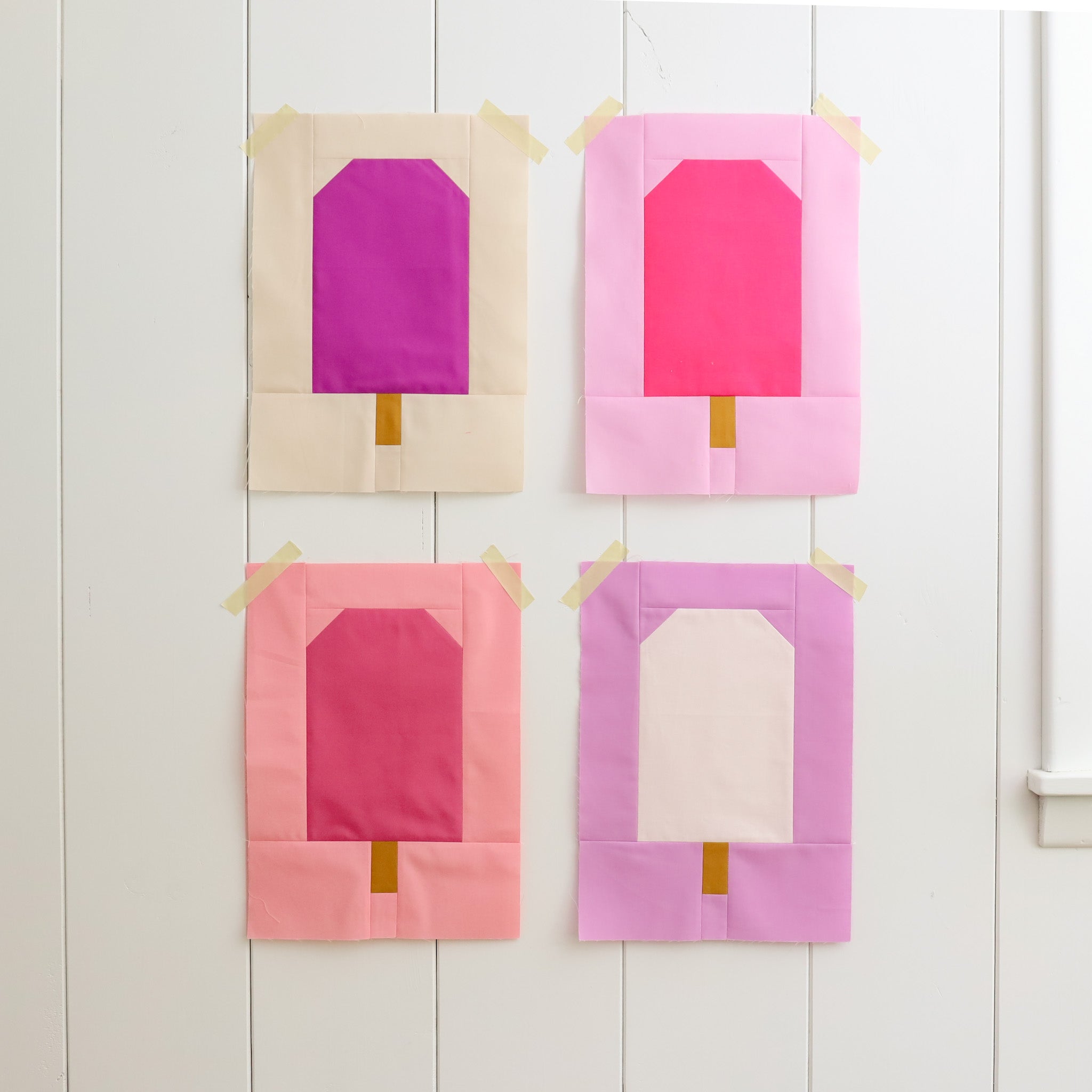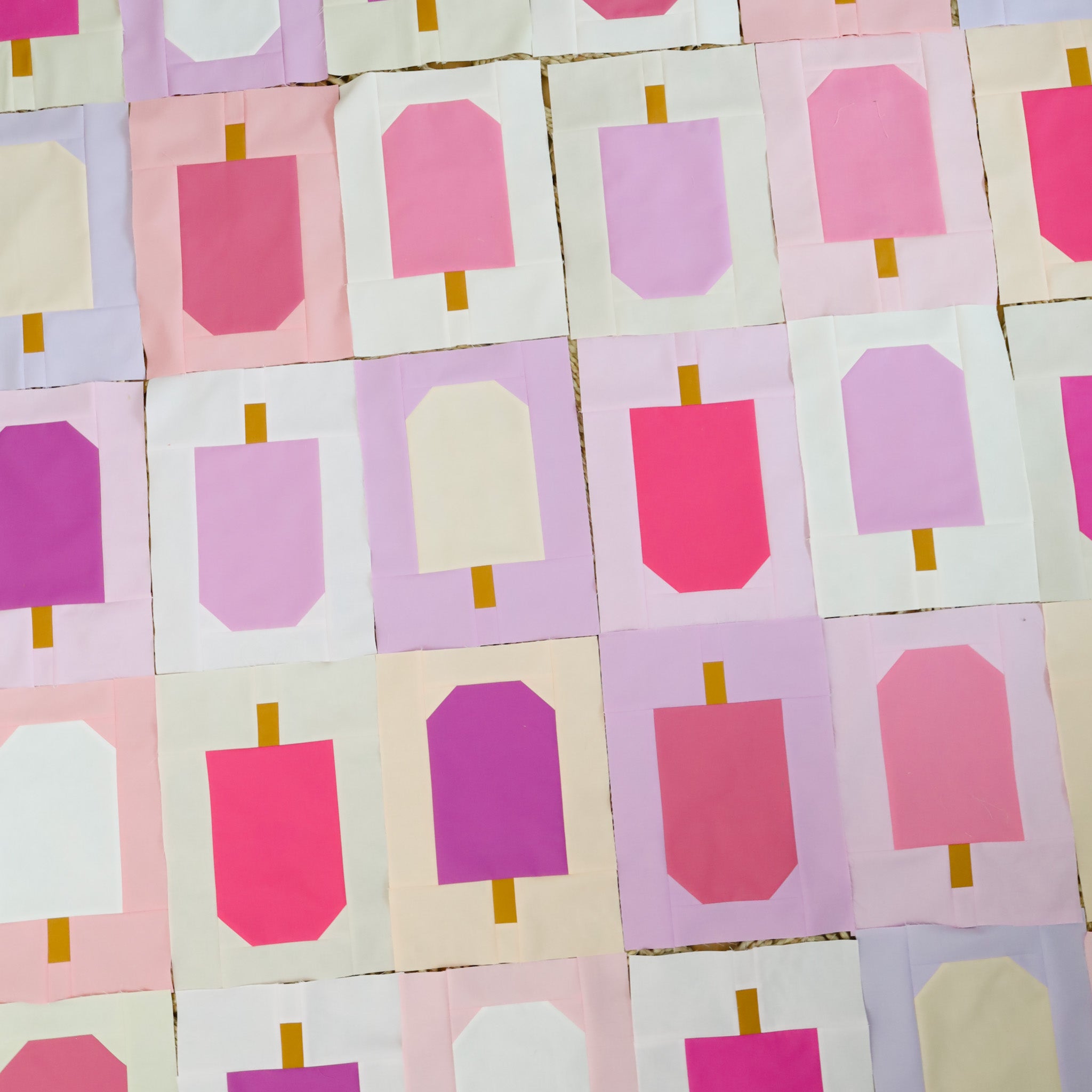Summer Pop QAL - Week 2

Hello and welcome back! It's Week 2 of the Summer Pop Quilt Along, which means we are starting to sew! Yay! Here's a look at our schedule. If you are just now joining us, click where you see an underline to catch up on the previous week!
- Week 1 - June 6th - Cut Fabrics
- Week 2 - June 13th - Sew 15 Blocks
- Week 3 - June 20th - Sew 15 Blocks
- Week 4 - June 27th - Assemble Quilt Top
.
WEEK 2
First and foremost, I highly recommend creating a test block before you get started. It's always better to fine-tune and make adjustments before you start working with your precious fabrics rather than after. First, let's take a look at Step 1 under the Block Assembly instructions on page 4.
MARKING
There are a few different ways to "draw" a line on the back of your Background squares. Here are some of my go-to methods:
- temporary marking pen - If you go this route, do some reading before you make a purchase. Some pens are "air erasing" meaning that the mark lasts for a set amount of time before it disappears. You wouldn't want this if you plan to mark your squares one day, then sew them the next. There are also "water erasing" and "heat erasing" pens. As a general rule of thumb, I only ever use pens if I'm marking the WRONG side of my fabric. I've heard too many horror stories of pen marks not disappearing or coming back after a set amount of time. This actually happened with some of my grandmother's quilts, so I'm a always a little leery. A safer option would be a chalk pen.

.

.
- hera marker or butter knife - These tools create a crease in your fabric, which is a much less permanent and cost-effective way to mark your fabric. This is my favorite marking method! Hera markers are relatively inexpensive and literally last forever, but an alternative is the back-side of a butter or table knife.

.

.
- iron - Another option is to press a crease in your fabric with a hot iron. This might be my least favorite option, just because I feel like the crease isn't quite as crisp, but it definitely still works!

.

.
- Diagonal Seam Tape or regular masking tape - This is also my favorite method because it require no marking at all! You place the tape on your machine, line up the red line with your needle (or edge of the tape with your needle if you are using masking tape). Then when you go to sew, you'll align one corner with the needle and the diagonal corner with the red line on the tape. As you stitch, keep that corner aligned and voila! Here is a video tutorial for the Diagonal Seam tape!

.
Diagonal Seam Tape alternative: masking tape

.
CHAIN PIECING
Once I have everything organized and laid out, then I sew my Background square to my Ice Cream pieces. Instead of doing once piece at a time, I always like to chain piece like-tasks. So I'll chain piece all Background squares to the left side of each Ice Cream piece. Then I'll repeat this on the opposite side. This simply means that you stitch all of your seams as one continuous "chain" piece to save time, energy and thread. Once you are finished, snip the connecting stitches and move on to trimming!
I do this for every step of making this block!

.
TRIMMING
Once both of the Background squares are sewn to each Ice Cream piece, you'll trim away the excess fabric to create your 1/4" seam. I like to trim these pieces while leaving my ruler in place for both seams, as seen below:

.
PRESSING SEAMS
I've found that pressing seams open for this step give the best results. To do that, use your fingers to open up the seam and press the wrong side with your iron. Try not to slide the iron around, but rather use an "up and down" motion. Then flip the block over and press the right side. If you plan to use a tailor's clapper, I usually wait to do that until the final step.

.
STEP 2
Step 2 under the Block Assembly instructions is to sew strips to the Ice Cream portion of your block. Any time you sew longer strips of fabric, there is a natural tendency for those strips to stretch as you sew. Pinning really helps decrease that risk and keep everything lined up and in place.

.
Note that everything should fit together nicely; you shouldn't need to do any trimming. If you go to sew the longer strips on the left and right edges of your block and they're longer than the block, then your seam allowance in the previous step was too large. If you go to sew the left and right pieces to the block and they're shorter than the block, then your seam allowance in the previous step was too small.
Recheck your seam allowance to make sure that it's accurate before moving forward!
Worst case, if you do want to trim as you go, you're welcome too, just make sure all of your blocks are the same size.
.
STRIP PIECING
The Stick portion of the block is "strip pieced" meaning instead of cutting up all of your pieces *then* sewing them together, you'll sew longer pieces together *then* cut it all apart. I always like to strip piece with a smaller stitch length so that my units don't unravel once I cut them apart. 1.8mm - 2.0mm should be good!
- Test out your seam allowance! This pattern requires a regular 1/4" seam but you'll definitely want to test it out before you go to town and get everything stitched up. Be sure you have a clear understanding of where your seam allowance needs to be before you strip piece everything!
- If your strip set measures less than 4", your seam allowance was too large. If your strip set measures more than 4", your seam allowance was too small. Again, make a test strip set (consider doing an entire WOF strip just for the practice) then place a ruler over the strip set to see where you are.
.
KEEPING PIECES SQUARE
I highly recommend using pins to keep things aligned and square. Also, take note of the edges that will be perpendicular to your seam. You'll want those to align, as well.

.

.
TIPS FOR FLAT SEAMS
If you have a tailor's clapper, this is a good place to use it. I normally press with my iron for a few seconds, then immediately follow up with pressing with the clapper for a few seconds. This helps keep the seams nice and flat.

.
An alternative (or an addition) to the clapper is to stack your blocks and place a ruler with something heavy on top. I usually let these sit overnight and it helps keep those seams super flat as well.

.
OTHER TIPS
- If your machine "eats" your fabric for the stitch & flip portion of these blocks, this can be a common problem! Check and see if your machine came with another needle plate. Ideally if you can use a needle plate with a single, small hole for the needle, that'll help. Also using a "leader" piece of fabric can help as well. This is just a scrap piece of fabric that you start sewing on to begin your seam, then you'll stitch off that fabric and onto the fabric for your quilt. The thought is that the tension from the leader will keep the following fabric above the needle plate. Once you get going, continue to chain piece.
- With this "stich and flip" technique, it's always a good idea to use a fresh needle (I really like sewing with a Microtex needle) and a 2 ply, 50 weight thread like Aurifil. If your thread is thicker, it can throw off your final results.
- Some people sew *just beside* the drawn line to create a "scant seam" situation. You can always do this and then trim away excess if you need to after you press the seam.
- Last but not least, make sure you're paying attention as you sew. What's wrong with this picture? haha!

.
.
GRAND PRIZE BUNDLE
Share a weekly progress photo for each of the 4 weeks of the QAL and you'll be automatically entered to win our GRAND PRIZE BUNDLE (valued at over $500!) Here's what's in the bundle:
- FREE seat in Free Motion Quilting Academy by String & Story
- FREE edge to edge long arm quilting for your Summer Pop quilt top by Stitch Lab Quilting
- FREE Robert Kaufman Palette Picks 24 piece FQ bundle by yours truly :)

.
Enter to win by sharing your weekly progress photo to your public Instagram account (note that if your account is private, we will not see your entry). Use the hashtags #summerpopQAL, #summerpopquilt & #loandbeholdpatterns and you'll be entered to win!
Please refrain from sharing photos of the *inside* of the pattern! This is copyrighted information for your eyes only. If you want to share a photo of part of the pattern, use the cover. :)
One lucky winner will be chosen at random at the end of the QAL. This giveaway is not sponsored by IG.

.
Sip & Sew
Last, but not least! I wanted to share about a "Sip & Sew" happening over on String & Story's IG page (@stringandstory) every Monday night at 7PM EST. HollyAnn and Darcy will be working on their Summer Pop quilts live and I invite you to join them for more Summer Pop tips, community and general entertainment. :)
Next week, we'll create the remainder of our blocks!
See you then!
Brittany


